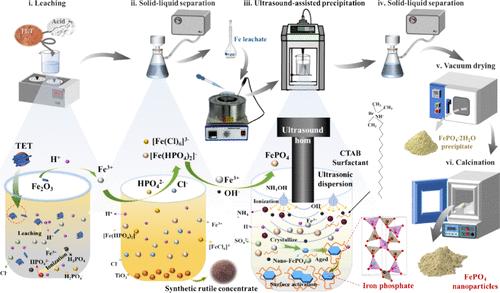当前位置:
X-MOL 学术
›
Inorg. Chem.
›
论文详情
Our official English website, www.x-mol.net, welcomes your
feedback! (Note: you will need to create a separate account there.)
Preparation of High-Purity Nano-Iron Phosphate from Titanium-Extraction Tailings by Co-Leaching Synergetic Ultrasonic-Enhanced Precipitation Process
Inorganic Chemistry ( IF 4.3 ) Pub Date : 2024-11-19 , DOI: 10.1021/acs.inorgchem.4c04229
Xianqing Xu 1 , Xiaoman Tian 1 , Zhengqi Guo 1 , Deqing Zhu 1 , Jian Pan 1 , Congcong Yang 1 , Siwei Li 1
Inorganic Chemistry ( IF 4.3 ) Pub Date : 2024-11-19 , DOI: 10.1021/acs.inorgchem.4c04229
Xianqing Xu 1 , Xiaoman Tian 1 , Zhengqi Guo 1 , Deqing Zhu 1 , Jian Pan 1 , Congcong Yang 1 , Siwei Li 1
Affiliation

|
The preparation of high-performance electrode materials from metallurgical solid waste is an effective strategy to address current energy and environmental challenges. This study utilizes a mixed acid leaching and ultrasound-assisted precipitation process to extract valuable metallic iron from titanium-extraction tailings (TET) to produce high-purity nano-FePO4 electrode material precursors with unique crystal structures. A leaching efficiency of 95.2% for Fe was attained by using the optimized process parameters, which included a mixed acid concentration of 4 mol/L, a liquid-to-solid ratio of 4:1, and a leaching temperature of 70 °C for 1 h. The optimal precipitation conditions were a pH of 2.0, a temperature of 60 °C, an aging time of 30 min, and a stirring speed of 600 rpm, resulting in FePO4 purity up to 99.6% and fine particle size. Thermodynamic calculations, combined with various characterizations, elucidated the leaching and precipitation mechanisms, highlighting the synergistic effect of phosphoric acid and hydrochloric acid in enhancing the leaching reaction. The thermogravimetric analysis indicated that the decomposition of residual ammonium chloride impurities requires calcination above 360 °C. This research not only provides new insights into the high-value, clean utilization of metallurgical solid waste but also supports sustainable resource recovery and environmental protection by transforming waste into valuable products.
中文翻译:

共浸协同超声增强沉淀法从钛萃取尾矿中制备高纯度纳米磷酸铁
从冶金固体废物中制备高性能电极材料是应对当前能源和环境挑战的有效策略。本研究利用混合酸浸和超声辅助沉淀工艺从钛萃取尾矿 (TET) 中提取有价值的金属铁,以生产具有独特晶体结构的高纯度纳米 FePO4 电极材料前驱体。采用优化的工艺参数,包括混酸浓度 4 mol/L、液固比 4:1、浸出温度 70 °C、1 h,Fe 的浸出效率为 95.2%。最佳沉淀条件为 pH 值为 2.0,温度为 60 °C,老化时间为 30 min,搅拌速度为 600 rpm,使 FePO4 纯度高达 99.6%,粒径细。热力学计算结合各种表征,阐明了浸出和沉淀机制,突出了磷酸和盐酸在增强浸出反应中的协同作用。热重分析表明,残留氯化铵杂质的分解需要在 360 °C 以上煅烧。 这项研究不仅为冶金固体废物的高价值、清洁利用提供了新的见解,而且通过将废物转化为有价值的产品来支持可持续的资源回收和环境保护。
更新日期:2024-11-19
中文翻译:

共浸协同超声增强沉淀法从钛萃取尾矿中制备高纯度纳米磷酸铁
从冶金固体废物中制备高性能电极材料是应对当前能源和环境挑战的有效策略。本研究利用混合酸浸和超声辅助沉淀工艺从钛萃取尾矿 (TET) 中提取有价值的金属铁,以生产具有独特晶体结构的高纯度纳米 FePO4 电极材料前驱体。采用优化的工艺参数,包括混酸浓度 4 mol/L、液固比 4:1、浸出温度 70 °C、1 h,Fe 的浸出效率为 95.2%。最佳沉淀条件为 pH 值为 2.0,温度为 60 °C,老化时间为 30 min,搅拌速度为 600 rpm,使 FePO4 纯度高达 99.6%,粒径细。热力学计算结合各种表征,阐明了浸出和沉淀机制,突出了磷酸和盐酸在增强浸出反应中的协同作用。热重分析表明,残留氯化铵杂质的分解需要在 360 °C 以上煅烧。 这项研究不仅为冶金固体废物的高价值、清洁利用提供了新的见解,而且通过将废物转化为有价值的产品来支持可持续的资源回收和环境保护。

































 京公网安备 11010802027423号
京公网安备 11010802027423号